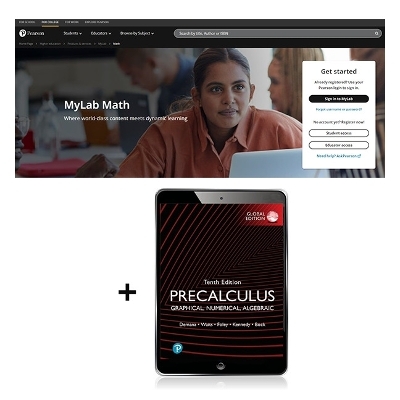
Precalculus: Graphical, Numerical, Algebraic, Global Edition -- MyLab Math with Pearson eText
Pearson (Hersteller)
978-0-6557-0966-4 (ISBN)
- Titel nicht im Sortiment
- Artikel merken
Precalculus: Graphical, Numerical, Algebraic provides a balanced approach to problem solving and a consistent transition from Precalculus to Calculus. A principal feature of this text is the balance among the algebraic, numerical, graphical, and verbal methods of representing problems: the rule of 4. This approach reinforces the idea that to understand a problem fully, students need to understand it algebraically as well as graphically and numerically.
The 10th Edition introduces graphing technology as an essential tool for mathematical discovery and effective problem solving. This edition also features a full chapter on Statistics to help students see that statistical analysis is an investigative process.
Franklin D. Demana Frank Demana received his master's and Ph.D. degrees in mathematics from Michigan State University. Currently, he is Professor Emeritus of Mathematics at The Ohio State University. As an active supporter of the use of technology to teach and learn mathematics, he is co-founder of the international Teachers Teaching with Technology (T3) professional development program. He has been the director or co-director of more than $10 million of National Science Foundation (NSF) and foundational grant activities, including a $3 million grant from the U.S. Department of Education Mathematics and Science Educational Research program awarded to The Ohio State University. Along with frequent presentations at professional meetings, he has published a variety of articles in the areas of computer-and calculator-enhanced mathematics instruction. Bert K. Waits Bert Waits received his Ph.D. from The Ohio State University and was Professor Emeritus of Mathematics there. Dr. Waits was co-founder of the international Teachers Teaching with Technology (T3) professional development program and was codirector or principal investigator on several large National Science Foundation projects. Dr. Waits published articles in more than 70 nationally recognised professional journals. He frequently gave invited lectures, workshops, and mini courses at national meetings of the Mathematical Association of America and the National Council of Teachers of Mathematics (NCTM) on how to use computer technology to enhance the teaching and learning of mathematics. Gregory D. Foley Greg Foley received B.A. and M.A. degrees in mathematics and a Ph.D. in mathematics education from The University of Texas at Austin. He is the Robert L. Morton Professor of Mathematics Education at Ohio University. Dr. Foley has taught elementary arithmetic through graduate-level mathematics, as well as upper-division and graduate-level mathematics education classes. He has held full-time faculty positions at North Harris County College, Austin Community College, The Ohio State University, Sam Houston State University, and Appalachian State University, and served as Director of the Liberal Arts and Science Academy and as Senior Scientist for Secondary School Mathematics Improvement for the Austin Independent School District in Austin, Texas. Dr. Foley has presented over 400 lectures, workshops, and institutes throughout the United States and, internationally, has directed or co-directed more than 60 funded projects totalling over $5 million. He has published over 50 book chapters and journal articles. Daniel Kennedy Dan Kennedy received his undergraduate degree from the College of the Holy Cross and his master's degree and Ph.D. in mathematics from the University of North Carolina at Chapel Hill. Since 1973 he has taught mathematics at the Baylor School in Chattanooga, Tennessee, where he holds the Carter Lupton Distinguished Professorship. Dr. Kennedy joined the Advanced Placement Calculus Test Development Committee in 1986, then in 1990 became the first high school teacher in 35 years to chair that committee. It was during his tenure as chair that the program moved to require graphing calculators and laid the early groundwork for the 1998 reform of the Advanced Placement Calculus curriculum. Dr. Kennedy has conducted more than 50 workshops and institutes for high school calculus teachers. His articles on mathematics teaching have appeared in the Mathematics Teacher and the American Mathematical Monthly, and he is a frequent speaker on education reform at professional and civic meetings. David E. Bock Dave Bock holds degrees from the University at Albany (NY) in mathematics (B.A.) and statistics/education (M.S.). Mr. Bock taught mathematics at Ithaca High School for 35 years, including both BC Calculus and AP Statistics. He also taught Statistics at Tompkins-Cortland Community College, Ithaca College, and Cornell University, where he recently served as K-12 Education and Outreach Coordinator and Senior Lecturer for the Mathematics Department. Mr. Bock serves as a Statistics consultant to the College Board, leading numerous workshops, and institutes for AP Statistics teachers.
Functions and Graphs
Polynomial, Power, and Rational Functions
Exponential, Logistic, and Logarithmic Functions
Trigonometric Functions
Analytic Trigonometry
Applications of Trigonometry
Systems and Matrices
Analytic Geometry in Two and Three Dimensions
Discrete Mathematics
Statistics and Probability
An Introduction to Calculus: Limits, Derivatives, and Integrals
| Erscheint lt. Verlag | 20.6.2022 |
|---|---|
| Sprache | englisch |
| ISBN-10 | 0-6557-0966-5 / 0655709665 |
| ISBN-13 | 978-0-6557-0966-4 / 9780655709664 |
| Zustand | Neuware |
| Haben Sie eine Frage zum Produkt? |